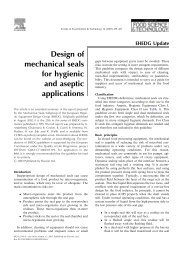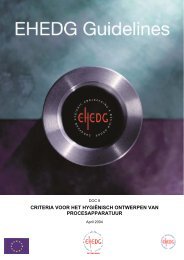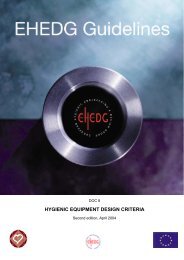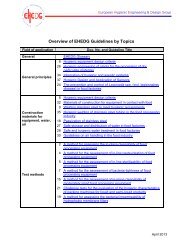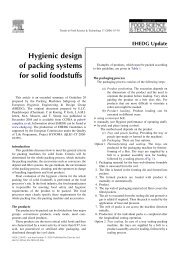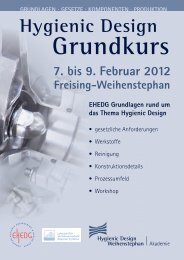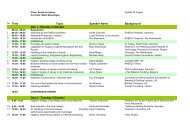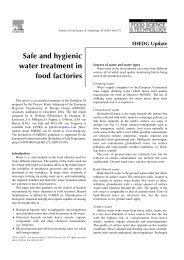Yearbook 2013/2014 - ehedg
Yearbook 2013/2014 - ehedg
Yearbook 2013/2014 - ehedg
Create successful ePaper yourself
Turn your PDF publications into a flip-book with our unique Google optimized e-Paper software.
72 Optimisation of tank cleaning<br />
The impact force and subsequent coverage create a<br />
footprint that is much larger and wall shear stress that is<br />
much higher than that provided by a static spray ball or<br />
rotary spray head. The magnitude of the wall shear stress<br />
in a rotary jet head footprint is approximately 104 Pa and<br />
decreases to about 7.5 Pa at approximately 150 mm from<br />
the impact centre. 3 This is significantly higher than the wall<br />
shear stress of between 1 and 5 Pa in the free-falling film<br />
created by a static spray ball.<br />
Figure 3. EHEDG certified Rotary spray head. The rotary spray<br />
head has a higher impact force and higher wall shear stress<br />
compared to the static spray ball. This reduces cleaning time.<br />
Rotary jet head<br />
Of the three automated tank CIP technologies, the rotary<br />
jet head is by far the most effective because it creates the<br />
highest impact force and highest shear stress (Fig. 4). The<br />
rotary jet head has between one and four cleaning nozzles,<br />
each of which disperses cleaning fluid through a welldefined<br />
jet. The rotary jet head rotates at a predefined speed<br />
to provide a full 360-degree indexed cleaning pattern. This<br />
ensures that the tank surfaces are thoroughly covered after<br />
a specified interval of time, which is dictated by the actual<br />
configuration of the machine.<br />
Figure 5. The wall shear stress in the footprint of an impinging<br />
jet from a rotary jet head, with water temperature at 20°C and<br />
pressure at 5 bar, is shown.<br />
The water from each jet of the rotary jet head creates a<br />
moving footprint on the tank walls in the 360-degree indexed<br />
cleaning pattern (as mentioned above). Because of the<br />
significantly higher impact force of the rotary jet head and<br />
subsequent increase in wall shear stress, it is possible to<br />
predict the required cleaning time more accurately when<br />
using a rotary jet head (Fig. 5).<br />
Chemistry and temperature are therefore no longer the most<br />
important parameters for cleaning efficiency. Instead, impact<br />
force is the most important parameter. By increasing the<br />
impact force on the tank surface, it is possible to reduce the<br />
time, flow, chemistry and temperature.<br />
In other words, when using a rotary jet head in most tank<br />
CIP scenarios, it is possible to cut the cleaning time required,<br />
reduce the amount of cleaning fluids used and realise<br />
energy savings because the cleaning fluids do not need to<br />
be heated to high temperatures in order to achieve optimal<br />
tank cleaning efficiency.<br />
Figure 4. EHEDG certified Rotary jet head. The rotary jet head is<br />
by far the most effective tank cleaning technology available today.<br />
Reduction of cleaning time and fluids<br />
consumption<br />
Recent studies indicate how the impact force from a rotary jet<br />
head is distributed in the impact area on the tank wall (Figures<br />
6 and 7). 4 The highest impact force occurs at the centre of<br />
the impact area; it then decreases by approximately 50% at<br />
a distance of 40 mm from the centre of the impact area. It<br />
is also important to note that the rotary jet head effectively<br />
cleans high-viscosity products, such as sticky foodstuffs,<br />
using water at ambient temperature in just 15 seconds after<br />
the jets hit the tank wall.



